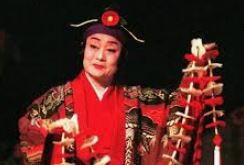
|
|
Nuchibana
published -Oct 11, 2019

------------------------------------------------------------------------------------------------------------------------
|
Nuchibana is a women's classical dance of Ryûkyû - koten onnaodori Ryûkyû buyû. The name, nuchibana, means "penetrated" or "threaded flowers" in reference to the red and white garland manipulated by the dancers while moving. The earliest version of nuchibana, now referred to as mutô nuchibana (original nuchibana), belonged to a court repertoire of dances from the Ryûkyû Kingdom. Unified by 1429, the Ryûkyû Kingdom developed into a culturally rich society defined by international trade and relations with a number of Asian countries including Japan, Korea, China, Vietnam, Thailand, and Indonesia. Historical sources suggest that the performing arts played a significant role in maintaining economic and diplomatic ties with these foreign powers. In fact, the Ryûkyû government appointed dance officials of noble ranking called odori bugyou (dance magistrates) to be in charge of performances for foreign dignitaries, both at home and abroad. However, with the dissolution of the Ryûkyû Kingdom and various changes brought about by Japanese assimilation policies enacted throughout the Meiji era (1868-1912), courtly dances of the nobility experienced a popularization that altered the style and composition of the dancing. A new genre of performance known as zô odori or miscellaneous dances developed separately from the classical repertoire.
Let us go pick cotton blossoms! But the blossoms are soaked in dew and cannot be picked. How I long to scoop up the cherry blossoms flowing along the swift nmning Shirase River and make a garland to place around the neck of my beloved. This red-threaded garland is for my beloved to wear. This white-threaded garland is for you children to take (Yamazato 1995:113) Present-day nuchibana consists of two sections differentiated by changes in movement style, music, tempo, and overall tone. The first half of the dancing includes action signs, bodily positions, and movement elements derived from the mut8 nuchibana version. Originally, only biologically male dancers, gendered female, performed classical women's dances such as mutô nuchibana, since women were forbidden on stage. This assignment of gender had to be produced through the performance of movements and positions denoted as "feminine." Even with biologically female performers in contemporary times, nuchibana maintains elements that ascribe gender to the performer and her actions. For example, modern nuchibana begins with a walking style that echoes the classical Ryûkyû aiyumi (the way to walk in Ryûkyû dances) in which the dancer moves as if "floating on a cloud." The most important aspect of this style is an action sign called suriashi (sliding feet) in reference to the dancer's footwork. The dancer lowers her center of gravity, bends her knees slightly, and then walks by sliding her feet across the floor, one after the other, gently elevating the toe at the end of each step. The body position employed during suriashi is also important for representing the ideal feminine body. Culturally embedded in Ryûkyû court aesthetics, the ideal feminine body exhibits long flowing lines and a delicate yet controlled overall body form. Therefore, as the dancer walks, she focuses her energy and strength on her mizoochi (the pit of the stomach, or the area of the solar plexus) in order to move smoothly. Suriashi is performed in-correctly if the dancer alters her height/level or appears to be bobbing up and down with each step.
Source: |
12 nuchibana tunes by Kiyoko Toma - tune in and let 'er run! |
©2019 Contact: ClickOkinawa.com
